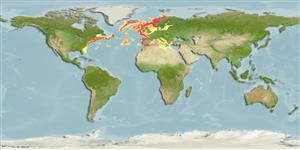Classification / Names
Common names from other countries
Main reference
Size / Weight / Age
Max length : 120 cm TL male/unsexed; (Ref. 5723); common length : 60.0 cm TL male/unsexed; (Ref. 4645); max. published weight: 2.5 kg (Ref. 5504); max. reported age: 11 years (Ref. 12324)
Environment
Marine; freshwater; brackish; demersal; anadromous (Ref. 89241); depth range 1 - 4099 m (Ref. 47198)
Climate / Range
Temperate; 1°C - 20°C (Ref. 88713), preferred 8°C (Ref. 107945); 72°N - 25°N, 82°W - 27°E
Distribution
Northeast Atlantic: Norway including Iceland and the Barents Sea, south to northern Africa. Throughout the western and central Mediterranean but absent from eastern Mediterranean and the Black Sea (Ref. 59043). Western Atlantic: Labrador, Canada to Gulf of Mexico in Florida, USA. Landlocked in Great Lakes, Finger Lakes, Oneida Lake and Lake Champlain, Canada/USA (Ref. 12269). Gulf of St. Lawrence to St. Jonhs River in Florida, St. Lawrence-Great Lakes basin; 1 record for Florida panhandle (Ref. 86798). Appendix III of the Bern Convention (2002). Annex II (excluding Swedish population) of the EC Habitats Directive (2007).
Countries | FAO areas | Ecosystems | Occurrences | Introductions
Short description
Vertebrae: 0. Anguilliform body (Ref. 51442). Jawless with a round sucker-like mouth and sharp teeth arranged in many consecutive circular rows (Ref. 88171). Presence of 7 branchial openings behind the eye (Ref. 51442, 88171). Lacks paired fins (Ref. 88171). Number of myomeres: 67-74 (Ref. 6258, 89241). Olive or brown-yellow on the dorsal and lateral part of the body, with black marblings; becomes lighter ventrally (Ref. 35388, 51442, 58137). Back, side and fins with prominent black mottling; oral disc as wide or wider than head (Ref. 86798). Adults: 11.4-120.0 cm TL. Body wet weight of the 120 cm TL individual was 2.3 kg. Maximum size attained by landlocked populations in the Laurentian Great Lakes, 60 cm TL. Body proportions, as percentage of TL (based on a variable number of specimens and sizes as indicated after the ranges): prebranchial length, 9.2-16.0 (in 46 specimens 19.2-82.75 cm TL); branchial length, 8.1-16.0 (in 46 specimens 19.2-82.75 cm TL); trunk length, 45.6-58.5 (in 42 specimens 25.6-82.75 cm TL); tail length, 22.0-42.2 (in 46 specimens 19.2-82.75 cm TL); eye length, 0.8-3.6 (in 49 specimens 13.5-82.75 cm TL); disc length, 4.5-9.3 (in 58 specimens 13.5-83.5 cm TL); snout length, 6.5-10.9 (in 41 specimens 25.6-82.75 cm TL). Urogenital papilla length, as a percentage of branchial length, in seven spawning males measuring 38.5-49.2 cm TL, 9.5-13.0. Spawning males develop a rope-like dorsal ridge ahead of the first dorsal fin and extending to the level of the posterior part of the branchial region, and hence, are sometimes called corded males. Dentition: supraoral lamina, 1 bicuspid tooth; infraoral lamina, 6-10 unicuspid teeth, the lateralmost sometimes bicuspid; 4 endolaterals on each side; endolateral formula, typically 2-2-2-2; 3 rows of anterials; first row of anterials, 1 unicuspid tooth; 5-7 rows of exolaterals on each side; 3 rows of posterials; first row of posterials, 10 unicuspid teeth; transverse lingual lamina strongly w-shaped, with 12-14 cusps, the median one not enlarged; longitudinal lingual laminae j-shaped, each with 12-14 cusps. Moderately well-developed marginal membrane. Velar tentacles, 2-3, smooth. Body coloration (preserved), newly-transformed individuals 13.5-17.5 cm TL have their colour grading from gray-bluish dorsally to silvery white ventrally while in individuals 45 cm TL or more the dorsal and lateral aspects become mottled and the ventral aspect remains uniformly pale. The iris is golden yellow. Lateral line neuromasts unpigmented or darkly pigmented. Extent of caudal fin pigmentation, 75% or more. Caudal fin shape, spade-like. Oral fimbriae, 114-150. Oral papillae, 24-33 (Ref. 89241).
IUCN Red List Status (Ref. 115185)
Threat to humans
Harmless
Human uses
Fisheries: minor commercial
Tools
Special reports
Download XML
Internet sources
Estimates of some properties based on models
Phylogenetic diversity index
PD50 = 1.0000 many relatives (e.g. carps) 0.5 - 2.0 few relatives (e.g. lungfishes)
Trophic Level
4.4 ±0.85 se; Based on food items.
Resilience
Low, minimum population doubling time 4.5 - 14 years (tmax=11; K 0.16; tm=5-12; Relative Fec = 233)
Vulnerability
High to very high vulnerability (72 of 100)
Price category
